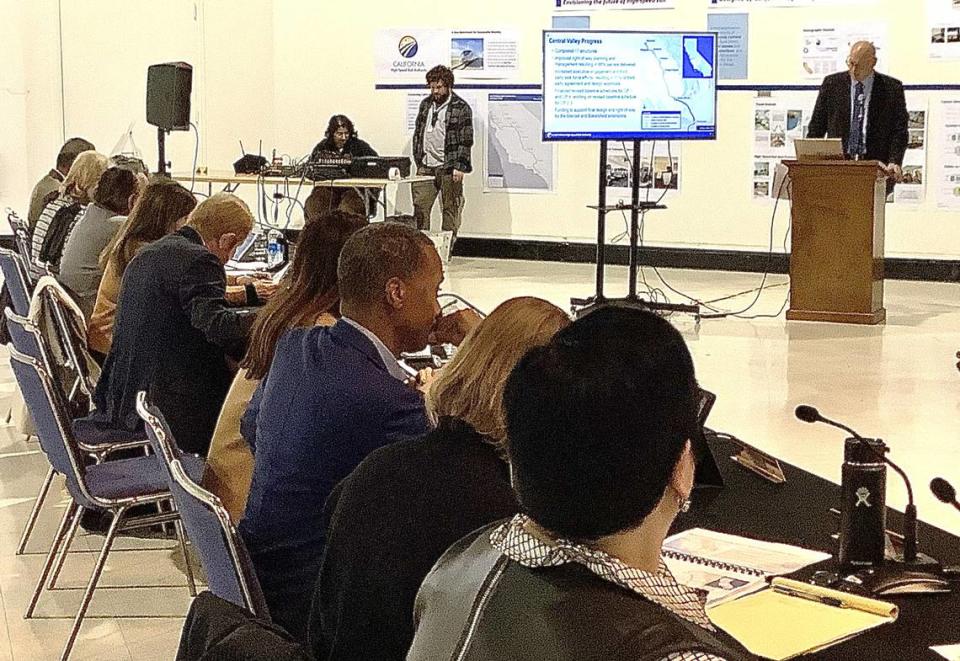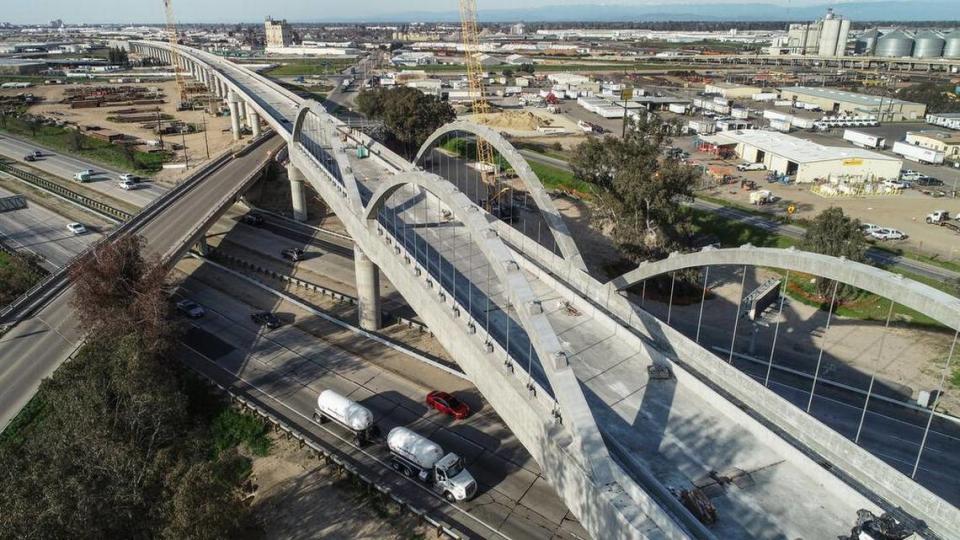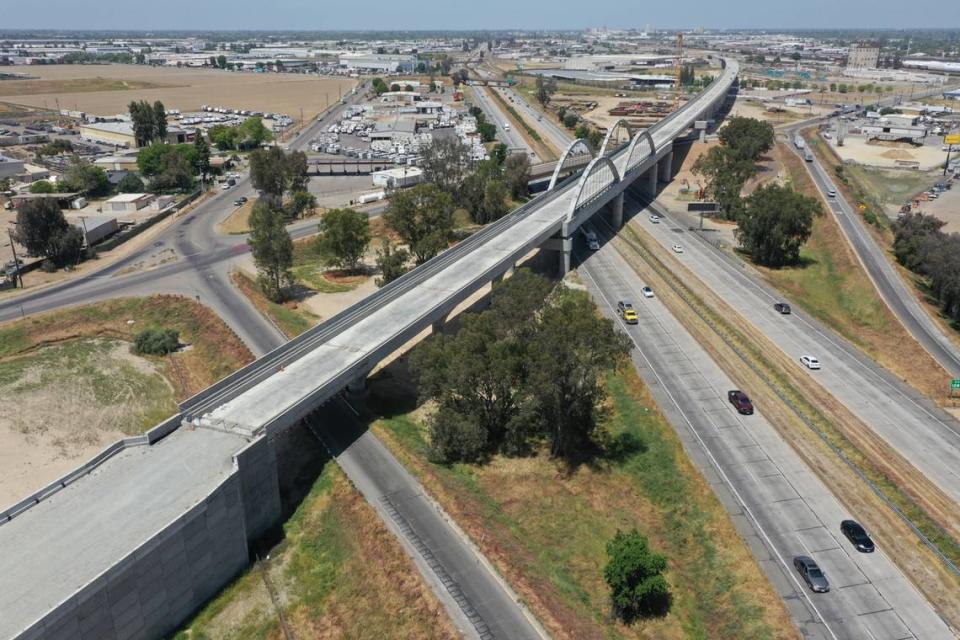High-speed rail cost, schedule hold steady — but money to keep building a big concern
- Oops!Something went wrong.Please try again later.
The latest cost estimates for construction of an interim operational segment of high-speed rail through the central San Joaquin Valley remain unchanged from a report last year to the state Legislature — an unusual note of stability after years of a rising price tag.
But one key source of funds to keep the work going is set to expire in 2030 unless state lawmakers agree to extend it.
The California High-Speed Rail Authority’s 2024 Business Plan, a draft of which was released Feb. 9 and is open for public comment prior to final approval April 11, forecasts the cost for its planned 171-mile stretch from downtown Merced to downtown Bakersfield within a range from $26.2 billion to almost $33 billion.
“We continue to be laser-focused on delivering our project in building blocks … to get the Merced-Fresno-Bakersfield system operational between 2030 and 2033,” rail authority CEO Brian Kelly said Thursday in a staff report presented to the agency’s board of directors.
The breadth of the range in cost estimates represents varying degrees in factors such as inflation, rising labor costs and unanticipated changes or modifications.
The price tag includes completion of three construction contracts spanning 119 miles from north of Madera to the Kern County community of Shafter that cover such “civil infrastructure” components as road overpasses, viaducts, bridges, trenches and relocated utilities.
It also encompasses future extensions of the route north to Merced and south to Bakersfield; the anticipated cost of laying two sets of steel tracks plus safety systems and overhead electrical power lines; developing passenger stations in Fresno, Merced, Hanford and Bakersfield; purchasing six electric trainsets for testing and eventual passenger service; and a maintenance facility to service the trains and serve as a headquarters for testing, including a driving simulator.

Continued flow of money for California train
But even as board members expressed relief that the cost and schedule are holding steady, they remain concerned about garnering the money that will be needed to bring a two-track Valley segment to completion in time to commence operations sometime between 2030 and 2033.
Over recent months, California’s bullet-train agency has received about $3.3 billion in new federal funds — one of the first major infusions of money from the Federal Railroad Administration under President Joe Biden since the Obama administration in the early 2010s. The rail authority has applications pending for another $4.7 billion for work in the Valley and elsewhere in the state.
“At the federal level, it can change with who’s in the White House, and we’ve lived with both sides of that,” Kelly told the board Thursday, referring to moves by then-President Donald Trump in 2019 to cancel a grant agreement for almost $1 billion in federal funds; Trump also threatened to seek repayment of another $2 billion in stimulus money that had already been largely spent by the state. The Biden administration restored the canceled grant in mid-2021.
Even with the federal grants, about 75% of the money that’s already been spent and which remains available for development and construction is coming from the state. Proposition 1A, a high-speed rail bond measure approved by California voters in 2008, provided $9.9 billion.
The rail authority has also relied heavily on cap-and-trade funds from the state’s greenhouse gas reduction program. Cap-and-trade money comes from companies who bid at state auctions to buy credits to offset their air pollution emissions.
The “cap” part of the cap-and-trade program is the limits that are placed on polluters’ emissions, and companies are required to get permits for each ton of carbon they produce as air emissions. The “trade” part comes from the ability of companies to trade for additional pollution capacity, buying allowances through auctions or from private sellers whose pollution comes in under their cap.
Through November 2023, Kelly said the rail authority has received $6.4 billion in money from cap-and-trade auctions since 2012. Future auctions are expected to generate between $5.3 billion and $8.9 billion before the current authorization for the program expires in 2030.

Looking to the future for high-speed rail
Kelly told the board that for work to continue in the Valley and beyond, “we have to solidify the state funding” by prevailing upon the state Legislature to extend cap-and-trade beyond 2030 — and to do so sooner rather than later.
“We cannot wait until 2030 to extend cap and trade,” Kelly said. “We have things to get done between now and then.”
And, he added, the agency needs to maintain the current positive relationship it has with the Federal Railroad Administration and U.S. Department of Transportation under the Biden administration.
Kelly became CEO of the rail agency in early 2018 and in January announced his intention to retire sometime this year.
“My strategy since I got here … was to first improve our credibility because I don’t think we can ask anybody for money until we start to identify achievable milestones and hit them,” Kelly said. “In my view, we’ve gotten much better at that.”
Benchmarks that so far remain largely unspecified, however, are when California may embark on construction beyond the Merced-Fresno-Bakersfield segment in the Valley, or anything more than ballpark estimates of the cost to complete the once-envisioned system of 220-mph electric trains between San Francisco and Los Angeles/Anaheim.
The new business plan projects that full completion of Phase 1 will range in cost between $88.5 billion and $127.9 billion. But those estimates are based on a 15% completion of designs for extensions from the Valley west and north to San Jose and San Francisco, and south from Bakersfield to Palmdale, Burbank and Los Angeles.
Work on those future extensions won’t commence until or unless the rail authority has nailed down sources of the money. As a result, those cost estimates could waver considerably depending on changes in design as planning advances, and in inflation and other factors by the time work would begin.
Proposition 1A also envisioned Phase 2 with extensions to Sacramento as well as to the Inland Empire and San Diego. No cost or schedule estimates for those lines are offered in the 2024 business plan.


